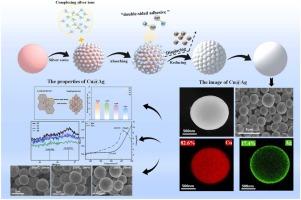致密,均匀的梯度调制合成Cu@Ag:低银,高电导率和抗氧化
IF 6.3
2区 材料科学
Q2 CHEMISTRY, PHYSICAL
引用次数: 0
摘要
对Cu@Ag复合材料的追求源于成本和性能之间的战略平衡。铜粉价格便宜,但容易氧化,因此需要镀银以增强抗氧化性和导电性。低银含量Cu@Ag复合材料提出了一个艰巨的挑战,需要创新的方法和路线,以均匀和致密的涂层。此外,Cu@Ag的电导率与其微观结构之间的复杂关系仍然难以捉摸,需要深入研究以揭示结构-性能关系并优化性能。在此,我们成功地开发了一种简单的梯度调制方法来制备具有薄而致密涂层的Cu@Ag。Cu@Ag的梯度调制合成涉及通过梯度添加银源和络合剂来初始调节种子诱导的生长和银层的形成。随后,通过梯度添加还原剂实现对银层晶粒尺寸的动态控制。采用两种络合剂,酒石酸钠作为第一络合剂,使一层银种子首先在铜的表面生长。接下来,l -组氨酸作为第二络合剂,发挥“双面粘合剂”的作用,能够与银和银离子形成连接。银离子被转移到铜表面的银种子上,然后同时置换和还原它们以完成涂层。结果表明,合成的Cu@Ag在银含量较低(17.4%)的情况下,可以获得完整均匀的银层(29 nm)。此外,Cu@Ag粉体具有较高的氧化稳定性、热稳定性、良好的固体除湿性能和极低的电阻率(10.642µΩ·cm)。此外,我们可以通过精心控制合成过程中的还原和位移持续时间来有效地定制晶粒尺寸。结果表明,镀银铜粉的电导率与其晶粒尺寸密切相关。本文章由计算机程序翻译,如有差异,请以英文原文为准。

Gradient-modulated synthesis of dense, uniform Cu@Ag: Low silver, high conductivity, and oxidation resistant
The pursuit of Cu@Ag composites stems from a strategic balance between cost and performance. Copper powder, inexpensive but prone to oxidation, necessitates silver coating to bolster oxidation resistance and conductivity. Low silver content Cu@Ag composites present a formidable challenge, requiring innovative methods and routes for uniform and dense coating. Moreover, the intricate correlations between Cu@Ag's electrical conductivity and its microstructure remains elusive, necessitating in-depth investigations to unravel the structure-property relationships and optimize performance. Herein, we successfully develop a facile gradient-modulated method to prepare Cu@Ag with a thin but dense coating layer. The Gradient-Modulated Synthesis of Cu@Ag involves initially regulating seed-induced growth and silver layer formation through the gradient addition of silver sources and complexing agents. Subsequently, dynamic control over the grain size of the silver layer is achieved via the gradient addition of reducing agents. Two complexing agents are employed, sodium tartrate as the first complexing agent, which enables a layer of silver seed to grow on the surface of the copper first. Next L-histidine is used as the second complexing agent, playing a role of a “double-sided adhesive” capable of forming link with both silver and sliver ion. Silver ions have been transferred onto the silver seed on the copper surface, then simultaneously displaced and reduced them to complete the coating. The result shows that the synthesized Cu@Ag can achieve a complete and uniform silver layer (29.012 nm) under a low silver content (17.4 %). In addition, the Cu@Ag powder exhibited high oxidative stability, thermal stability, good resistance to solid state dehumidification and extremely low resistivity (10.642 µΩ·cm). Furthermore, we can effectively tailor the grain size by meticulously controlling the reduction and displacement durations during the synthesis process. Results indicated that the conductivity of silver-coated copper powder is intricately linked to its grain size.
求助全文
通过发布文献求助,成功后即可免费获取论文全文。
去求助
来源期刊

Journal of Alloys and Compounds
工程技术-材料科学:综合
CiteScore
11.10
自引率
14.50%
发文量
5146
审稿时长
67 days
期刊介绍:
The Journal of Alloys and Compounds is intended to serve as an international medium for the publication of work on solid materials comprising compounds as well as alloys. Its great strength lies in the diversity of discipline which it encompasses, drawing together results from materials science, solid-state chemistry and physics.
 求助内容:
求助内容: 应助结果提醒方式:
应助结果提醒方式:


